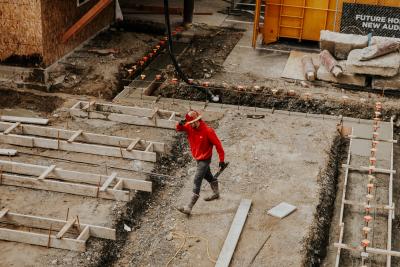Caveat emptor – time for change?
Russell Hewitson is a solicitor and Associate Professor of Law at Northumbria University. He is chair of the Law Society’s Conveyancing and Land Law Committee.
Posted:
Time to read:
The purchase of a home is probably the largest financial transaction that most people will make. At common law the principle of caveat emptor or “let the buyer beware” places the buyer under an obligation to discover any physical defects in the property they are buying.
However, in Miller v Cannon Hill Estates Ltd [1931] 2 KB 113 it was established that when a property in the course of construction is sold there is an implied warranty that when completed the property will be fit for human habitation.
Subsequently in Jennings v Tavener [1955] 2 All ER 769 a breach of this implied warranty was found in relation to cracked and weakened foundations but not for other more minor defects since “neither of those alone would have made the bungalow unfit for habitation” (at p.774).

Photo by Scott Blake on Unsplash
Later in Hancock v BW Brazier (Anerley) Ltd [1966] 1 WLR 1317 Lord Denning MR said at 1332 that when a buyer purchases a property from a builder who contracts to build it, a threefold warranty is implied:
- that the builder will do his work in a good and workmanlike manner;
- that he will supply good and proper materials; and
- that it will be reasonably fit for human habitation.
The implied warranty is collateral to the contract of sale and so does not merge on completion. However, since it is a matter of contract, it can be excluded either by express agreement to the contrary or by an inconsistent contractual provision.
The existence of this implied warranty was most recently acknowledged at by Lewison LJ in The Mayor and Commonalty and Citizens of the City of London v Various Leaseholders of Great Arthur House [2021] EWCA Civ 431 ('Great Arthur House') at [50]. The application of this implied warranty of habitability is limited to homes purchased in the course of construction and to homes so defective as to render them uninhabitable.
A similar implied warranty for new homes applies in the US state of Alabama since the decision in Cochran v Keeton 252 So. 2d 313 (1971). Alabama, along with a number of other US states, applies caveat emptor; though as Elizabeth Murphy has identified, the Alabama courts have not restricted the warranty to cases where the home is so defective as to render it uninhabitable, instead applying it where the defective condition has decreased the fair market value of the home, resulting in damage to the buyer.
In practice caveat emptor means that a buyer should always have a survey carried out before the exchange of contracts. However, in relation to a new build flat this can raise a number of issues. A buyer may feel that they do not need a survey as the flat will have the benefit of an NHBC Buildmark guarantee or similar cover. The limitations of the NHBC scheme have already been considered by Bright & Davey in a previous blogpost. The buyer may also feel that no survey is necessary as maintenance and repairs will be taken care of by the building’s management company. However, a survey is essential in preventing unexpected repair and maintenance costs and identifying underlying structural issues affecting the whole building that could end up affecting the buyer’s home and service charge contributions.
Another issue is the extent of the survey and whether, in addition to highlighting any areas of concern relating to the flat itself, the surveyor is able also to consider the construction and defects of the wider block or development. This was highlighted by Lewison LJ in Great Arthur House who said at [50] "it cannot be supposed that the purchaser of single flat in a large block would commission a structural survey of the whole building before committing himself to acquiring a long lease."
Many new build flats are bought ‘off plan’ which means that the buyer purchases their home before the developer has finished building it and so they have no opportunity of having a survey carried out before exchange of contracts. The best a buyer might be able to do is to have a snagging survey carried out before they complete their purchase. However, many developers will not allow such inspections to be done before completion and if they do it may be limited to just the flat and not the whole building.

Photo by Chris Barbalis on Unsplash
So, is it now time to consider a change from caveat emptor to caveat venditor?
The suggestion that caveat emptor be changed is not new. In 1988 the Law Commission’s Conveyancing Standing Committee provisionally proposed that “a vendor of land should be under a positive duty to disclose all material facts about the property he is selling, providing he is aware of those facts or ought reasonably to be aware of them. To this significant extent the caveat emptor rule should be reversed.”
The Committee reached this proposal by looking at the various exceptions to the rule, one of which was that there may be a duty to reveal a physical defect known to the seller which would endanger the buyer’s life. However, this suggestion was later rejected as the Law Commission noted in its 24th Annual Report and instead a number of other reforms were put forward including searches being carried out by sellers and the provided to buyers.
The last Labour Government attempted to implement these reforms with Home Information Packs (HIPs). These provided property information 'upfront' including initially a home condition report, but this requirement was subsequently dropped as there was some suspicion by buyers that as the reports were provided by the seller, they may not be impartial. In addition, they would have been of little value for off plan purchases. In Scotland, where a survey must form part of the information in the Home Report provided by a seller to a buyer, there is an exception for new properties that are being sold off-plan or to the first occupier
Following a phased implementation, HIPs were fully introduced by April 2009. However, they were widely criticised and suspended by the incoming Coalition Government in May 2010. The Coalition Government supported a voluntary, industry-led approach to improving the home buying and selling process, believing that improvements would be driven by the market led development of innovative products.
The Conservative Party Manifesto 2017 committed to “reform and modernise the homebuying process so it is more efficient and less costly”. In October 2017, the Government launched a Call for Evidence seeking views on how to improve the homebuying process. The Government’s consultation response, published on 8 April 2018, concluded that there was no ‘silver bullet’ – no single fundamental change which would improve the process. Instead, the Government proposed a number of smaller, incremental changes to the current system, which when taken together are intended to make the process “quicker, cheaper and less stressful”.
As part of these changes, a number of schemes to provide buyers with “up front” information about a property have been proposed. The Law Society is piloting a scheme involving a new version of its TA6 Property Information Form. The Law Society has identified what it calls “key early marketing questions” that can be completed upfront in a transaction. It is hoped that the answers to these questions will help to inform a buyer’s decision to purchase and will support industry-wide initiatives to begin the systemic collection of up-front information about a property. Whilst the provision of up-front information may assist a buyer of an existing flat, it may be of little use to a buyer where the purchase is ‘off plan’.

Photo by Becca Tapert on Unsplash
The Law Commission’s provisional proposal in 1988 would have applied to all types of property. As it can be extremely difficult for a buyer of a new-build flat to have a survey carried out of the whole building, could a possible way forward be to abolish caveat emptor for new-builds whilst retaining it for used homes, perhaps along the lines of the implied warranty which is applied in Alabama?
After the purchase of a home, the next largest financial transaction a person will usually make is the purchase of a motor vehicle. However, buying a car could not be more different from buying a home so far as caveat emptor is concerned. Whilst consumers have some protection under consumer protection legislation, allowing them to return goods that are not of an acceptable standard, these protections do not apply to the purchase of a home. But could consumer protection law provide some remedy for a buyer?
But is any of this really necessary? The Law Society has provided guidance in its practice note on the Consumer Protection from Unfair Trading Regulations 2008 and their implications for conveyancing practice. The Law Society suggested that consumer protection laws might impose a requirement on the seller’s conveyancer to disclose defects that they know about. As a consequence, it would seem that a seller cannot withhold information about defects in a property from the buyer. Together with the implied warranty, could this assist the buyer of a new build flat in the absence of reform of caveat emptor?
--
How to cite this blogpost (Harvard style)
Hewitson, R. (2021) Caveat emptor - time for change? Available at: https://www.law.ox.ac.uk/housing-after-grenfell/blog/2021/06/caveat-emptor-time-change (Accessed [date])
Share:
